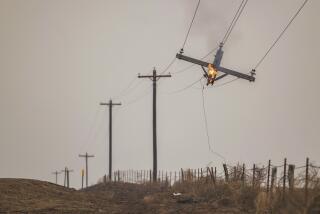Punishing drought gets worse across the U.S.
This year’s punishing drought is getting worse across much of the nation, federal officials said Monday.
“Severe to extreme drought affected about 33%” of the continental U.S. in June, the National Oceanic and Atmospheric Administration reported. That was an increase of nearly 10 percentage points from May, the agency said.
What’s more, when “moderate drought” was factored in, about 55% of the continental U.S. was affected, NOAA said.
The hardest-hit areas, according to NOAA, are the southern to central Rockies, Central Plains and the Ohio Valley, bringing yellowed crops and cracking soil. Much of the corn and soybean farmland in Indiana lies as dry as the palm of a needy hand: Brother, can you spare a drop? All but six of the Hoosier state’s 92 counties have banned the burning of debris.
The 55% of the country under moderate to extreme drought is the biggest portion since 1956, NOAA said. Although that’s bad, it’s considerably better than the peak in July 1934, during the Depression “Dust Bowl” days: 80%.
Retired 83-year-old Arkansas farmer Don Hudson told CNN things were about as bad as he’s seen. “It’s very brown right now; ain’t no grass at all,” he said. “We’re still feeding hay because the cows aren’t even going out to graze.”
This year’s drought will probably be economically punishing, as dryness can be a deceptively widespread and damaging disaster. A nationwide 1988 drought squeezed out $15 billion in crop losses, with $40 billion in losses nationwide.
For boat traffic on the Mississippi River, this year’s drought — and the lower river levels that came with it — is a drastic flip from last year’s impressive highs, when huge rains and leftover snowmelt sent historic amounts of water rushing toward the Gulf of Mexico.
Now, barges and navigators are trying to avoid running into each other in shallower, narrower river channels.
“Captains and crews know how to navigate through waters high or low,” Keel Hunt, spokesman for the Ingram Barge Co., told the Associated Press. “In a time like this, however, it’s a particular challenge because in some cases it’s just very difficult to move a barge full of products.”
As for the big picture when it comes to climate, NOAA says it’s not that the U.S. is getting particularly dry from a historical standpoint, as in the 1930s and 1950s. Nor did last year mean the U.S. was like the notably wet 1980s and 1990s. Rather, the first years of the 21st century have seen “extensive drought and extensive wetness.”
The best and worst of both worlds.
More to Read
Sign up for Essential California
The most important California stories and recommendations in your inbox every morning.
You may occasionally receive promotional content from the Los Angeles Times.











